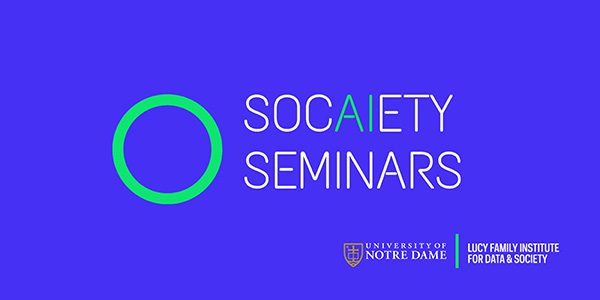Understanding the Body with W.B. Yeats & James Joyce – Blindness and Insight
Subscribe to the ThinkND podcast on Apple, Spotify, or Google.
Featured Speakers:
- Declan Kiberd, Emeritus Donald and Marilyn Keough Professor of Irish Studies and Professor of English and Irish Language and Literature
- Briona Ni Dhiarmada, Thomas J. & Kathleen M. O’Donnell Professor of Irish Studies and Concurrent Professor of Film, Television, and Theatre
The second session in the second installment of the Kylemore Book Club featured Declan Kiberd, the Emeritus Donald and Marilyn Keough Professor of Irish Studies and a Professor of English and Irish Language and Literature at the University of Notre Dame. Lisa Caulfield, the Director of the Notre Dame Global Center at Kylemore Abbey, moderated the event. This session focused on the topic of blindness, using examples from literature written by both Joyce and Yeats, as well as the example of various other Irish writers to explore the effects of blindness on the work of artists. The panelists also discussed the beliefs of Irish culture surrounding mental illness and the differences between blind and sighted artists.
Kiberd began by presenting on the topic of blindness and insight, invoking the use of texts by Yeats and Joyce featuring blind characters. In the passage highlighted by Joyce, the protagonist helps his young, blind neighbor while trying to understand what it would be like to be him. In the passage from Yeats, a blind man is carried by a fool character to whom he gives instructions. Kiberd expressed his fascination with the fact that both authors explore the possibility of blindness giving an individual a deeper vision and a richer awareness of the world around them. Invoking a metaphor from Gulliver’s Travels, Kiberd questioned the possibility of artists with their sight seeing too much of the world and seeing it too closely, not being able to see the bigger picture. This question also arose from the example of the play “The Well of the Saints” written by John Millington Synge. This play features a blind couple that is enthralled with the beauty of themselves and the world around them until a saint cures their blindness and, ultimately, ruins their lives by revealing their lack of beauty and the chaos of the world.
Guided by questions from Caulfield, Kiberd addressed the similarities and differences between artists with their sight and those without. Because his inspiration for the topic of blindness and insight came from his college roommate who suffered the transition from sight to blindness, Kiberd used him as an example by saying that he likely knew the space of their houses better than he did. This highlighted a realization for the participants that becoming too comfortable with a space and not having to concentrate to understand may in fact be the disability rather than not being able to physically see it. Seeing a space, whether physical or hypothetical, through the eyes of one who has never experienced it before allows one to see its full beauty. Kiberd and Caulfield also discussed examples of artists who close their eyes while playing music or turn their backs to an audience when performing, such as Emma O’Sullivan, almost imitating one who is blind to improve their concentration and artistic output.
Kiberd then moved to discuss the beliefs of Irish culture about the mentally ill and disabled. Frequently using the phrase ‘duine le Dia’, which means “a person with God”, Kiberd said that the Irish see the mentally ill not as such, but as further along on the journey that all humans are on back to God and the divine world. The mentally ill in Ireland are allowed to remain in their communities, seeing communal living as the best treatment for them. Caulfield concluded the session with a participant comment highlighting the need for American culture to become more accepting of those with mental illnesses and disabilities, the need to become a more welcoming culture to those who likely have a more insightful view of the world than those currently thought to be more intelligent.
- Those who are blind are often thought to have their other senses heightened and a deeper vision of the world. (4:55)
- There is a long history of blind artists and musicians, raising the question of whether being blind allows an artist to better see the world through a lens of creativity. (15:31)
- Many artists close their eyes while dancing or playing music to help them concentrate, a kind of emulation of the perspective of the blind. (17:28)
- If one feels too comfortable in a space, its unique qualities are not seen. Seeing a place through a perspective of foreignness may help you to see its full beauty. (31:27)
- The Irish see those with mental illness as further progressed on the journey all of humanity is on back to the realm of the divine. The mentally ill in Irish society are not institutionalized, but instead continue to live in their communities. (42:12)
- “It struck me that both of these writers are raising very important questions about disability and also about whether it can be or can’t be a source of vision.” (Declan Kiberd, 8:53)
- “People with mental problems were called “a person with God”, someone who had already in a sense gone back to God.” (Declan Kiberd, 14:01)
- “One thing that has often struck me is that much of the description of the world of the blind is given not by blind people themselves.” (Declan Kiberd, 20:57)
- “It goes back to what Freud said, that we all have idealized images not just of ourselves, but of the beloved, of other people, and yet somehow they have to be harmonized with the actual people that exist.” (Declan Kiberd, 27:29)
- “One could even construct an argument that being an artist is in some ways disabling because one is super sensitive and the loud robustness of the everyday world may make it a difficult place for the artist to negotiate.” (Declan Kiberd, 32:12)
Related Content
Climate Change and The Limits of Narrative
Join the Kellogg Institute for the introductory session of a workshop refining Kellogg Faculty Fellow Roy Scranton’s draft book project “Ethical Pessimism: Climate Change and...
View EventReunion 2024
Alumni Education Programming Click each program title to learn more. To return to the Reunion 2024 website on my.nd.edu please click here. ND Perspectives: Election 2024 and the...
Read ArticleA Brave New World of AI Governance
Explore the connection between data, geopolitics and governance, regulation, self-regulation while discovering examples of good and bad practices in various sectors, such as...
View Event


